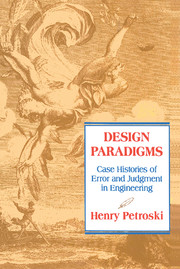Book contents
- Frontmatter
- Contents
- Preface
- 1 Introduction
- 2 Paconius and the Pedestal for Apollo
- 3 Vitruvius's Auger and Galileo's Bones: Paradigms of Limits to Size in Design
- 4 Galileo and the Marble Column
- 5 Galileo's Confirmation of a False Hypothesis
- 6 The Design and Collapse of the Dee Bridge
- 7 The Britannia Tubular Bridge
- 8 Failure as a Source of Engineering Judgment
- 9 The Design Climate for the Tacoma Narrows Bridge
- 10 Historic Bridge Failures and Caveats for Future Designs
- 11 Conclusion
- Bibliography
- Index
- Frontmatter
- Contents
- Preface
- 1 Introduction
- 2 Paconius and the Pedestal for Apollo
- 3 Vitruvius's Auger and Galileo's Bones: Paradigms of Limits to Size in Design
- 4 Galileo and the Marble Column
- 5 Galileo's Confirmation of a False Hypothesis
- 6 The Design and Collapse of the Dee Bridge
- 7 The Britannia Tubular Bridge
- 8 Failure as a Source of Engineering Judgment
- 9 The Design Climate for the Tacoma Narrows Bridge
- 10 Historic Bridge Failures and Caveats for Future Designs
- 11 Conclusion
- Bibliography
- Index
Summary
Possibly the greatest tragedy underlying design errors and the resultant failures is that many of them do indeed seem to be avoidable, yet one of the potentially most effective means of improving reliability in engineering appears to be the most neglected. Historical case studies contain a wealth of wisdom about the nature of design and the engineering method, but they are largely absent from engineering curricula, perhaps because the state of the art always seems so clearly advanced beyond that of decades, let alone centuries or millennia, past. However, the state of the art is often only a superficial manifestation, arrived at principally through analytical and calculational tools, of what is understood about the substance and behavior of the products of engineering. Anyone who doubts this assertion need only look to the design errors and failures that occur in the climate of confidence, if not hubris, known as the state of the art.
The fundamental nature of engineering design transcends the state of the art. Thus it follows that historical case studies that illuminate those aspects of conceptualization, judgment, and error that are timeless constants of the design process can be as important and valuable for understanding technology and its objects as are the calculus or the latest computer software. The lessons of the past are not only brimming with caveats about what mistakes should not be repeated but also are full of models of good engineering judgment.
- Type
- Chapter
- Information
- Design ParadigmsCase Histories of Error and Judgment in Engineering, pp. ix - xiiPublisher: Cambridge University PressPrint publication year: 1994



